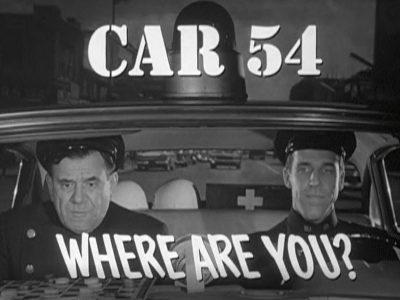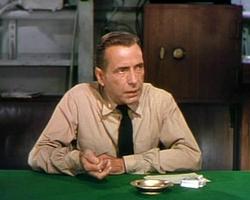
There’s a holdup in the Bronx,
Brooklyn’s broken out in fights;
There’s a traffic jam in Harlem
That’s backed up to Jackson Heights;
There’s a Scout troop short a child,
Khrushchev’s due at Idlewild …
Car 54, Where Are You?
Car 54, Where Are You? was a police comedy that aired on NBC from 1961 to 1963. The Car 54 was the patrol car for Officer Gunther Toody and Officer Francis Muldoon, two New York City police officers in the fictional 53rd precinct in The Bronx. As it turns out, one episode was directly related to the current issue of police reform.
The episode in question is “Toody & Muldoon Crack Down.” It aired on January 21, 1962, and can be seen on YouTube. In the show, the Chief Inspector is being driven through the part of the 53rd precinct patrolled by Toody and Muldoon. The Inspector becomes apoplectic. He fumes as he spots one infraction after another. In the end, he lists a total of 107 violations.
The Inspector then barges into the office of the captain of the precinct. You can see the smoke pouring forth from all the openings in his head as he berates the captain for the massive breakdown in police authority. He demands immediate correction. When Toody and Muldoon return from their shift, the Captain reads them the riot act. They are given one day to get their act together.
Meanwhile back at headquarters, the Inspector has a researcher document the failure of the 53rd precinct to follow police procedures. The next day, the researcher presents two maps with dots for each infraction. The first map exhibiting minor violations shows Toody and Muldoon’s sector as practically a solid block. The sector is overwhelming one of infractions especially in comparison with the other sectors. The second map presents a quite different perspective. It shows major crimes. The Toody and Muldoon sector is blank, there are no major crimes in that sector. By contrast, the other sectors show some major crimes.
The Inspector comes across at first as a gruff hard-ass but that is a false view. He genuinely wants to know how there could be no major crimes in this sector in the Bronx. He decides to do some surreptitious fieldwork to discover the truth. To give only two examples:
1. He learns that many of the children in the sector are named “Gunther” or “Francis.” This is because so many children in that neighborhood were born in the patrol car since ambulances could not be relied on.
2. He learns that that local troublemaker, an ethnic mug who had a record of a series of fistfights with cops, has given up punching cops: how can he hit the cops who helped his mother home from church!
Yes, this was a TV series and should not be taken literally. But what the TV series presents is a large Jane Jacobs community. People know each other, look out for each other, and help each other. The police are part of this community, not outsiders patrolling a foreign territory. The details of the various incidences are secondary to the conceptual portrayal of the police as integral to the community.
This approach is even more true with Sheriff Andy Taylor in Mayberry. He is even more a part of the community since he has a son, Opie, in the local school. Schools are an important part in developing the social fabric of a community. Schools bring people together in a wide range of activities throughout the nine-month school year. Schools are a critical part of a healthy community. So while Sheriff Taylor is a lot like Toody and Muldoon in his policing, he also is a father. He has a connection with the community with more than his police job. He really is one of them.
True the Bronx precinct and Mayberry town of the 1960s differ from the world today. They both are white. There were no broken families, no drugs, no mental illness, and no guns. Nonetheless, the concept of community police remains valid.
Some communities were more tense. Consider the situation for Officer Krupke. He has his own song in West Side Story.
[RIFF]
Dear kindly Sergeant Krupke
Ya gotta understand
It’s just our bringin’ upke
That gets us outta hand
Our mothers all are junkies
Our fathers all are drunks
Golly Moses natcherly we’re punks
[ALL]
Gee, Officer Krupke, we’re very upset;
We never had the love that every
Child oughta get
We ain’t no delinquents
We’re misunderstood
Deep down inside us there is good!
[RIFF]
There is good!
[ALL]
There is good, there is good
There is untapped good
Like inside, the worse of us is good
[TIGER]
That’s a touchin’ good story
The violence is greater in West Side Story than in Car 54 or The Andy Griffith Show. The world is grittier. The personal circumstances are more challenging. Still the police officer is known by name, knows the name of the people in the community, and is part of it. Do you know the name of the police officers who patrol where you live?
Somewhere along the line, the world changed. The 53rd precinct became Fort Apache. Sheriff Taylor became Serpico. The entire media presentation of the police changed. Once upon a time, detectives were not violent and scarcely visible. How many shootouts were there in Dragnet? Perry Mason would dispatch private detective Paul Drake without there being any violence. Today TV police tend to be detectives always investigating murders or drug gangs or both. SWAT teams are ubiquitous. There are shootouts reminiscent of the TV Old Wild West that bear little resemblance to the real world. Too often police are not part of the community but at war with it. They live elsewhere from where they work.
Right now, police reform is a hotly debated subject. A lot of the discussion is about rules, regulations, training, and databases. These items are important but they don’t get to the heart and soul of the matter. A key issue is one of trust. It doesn’t exist. Passing laws isn’t going to cause it to exist either. If the people being policed don’t trust police and vice-versa, then all the regulations in the world are not going to change the fact that every encounter is potentially explosive.
Sheriff Taylor would have walked Rayshard Brooks home…or driven him…or called a relative. He would not have him take a breath test. For what purpose was the test taken? Once the officer requested a breath test, he changed Brooks from being a person who needed some help to being a potential criminal. There was no need to make that change. Just because it was perfectly legal to request it doesn’t mean it should have been done. Sheriff Taylor never would have done it. For him Brooks would have remained a person and never have become a potential criminal. This was a “don’t ask, don’t tell” community police situation that escalated because the officer did ask.
Similarly Toody and Muldoon never would have knelt on the back of Floyd. If Floyd was having some trouble, they probably would have helped out. Maybe even lent him some money. Since they would have known the community, they would have known where to find Floyd and he would have known them as well. It never would have escalated as it did.
If Toody and Muldoon or Taylor saw someone running, they would have waved at him. They would have known he was in training for the track team, late for work, trying to lose weight or whatever. They certainly would not have been suspicious about someone they knew.
True, I have been comparing fictional TV shows to real world situations. But the concept of community policing exhibited by Toody and Muldoon, Taylor, and Krupcke provide a better model for how the police should operate than how the police operate today. Can such a change be made today given the current environment? Obviously not. Let’s not be naïve. Come let us reason together is not possible today. Still, these TV programs show what to aim for if people in the real world are serious about wanting to solve problems.





